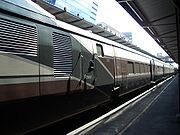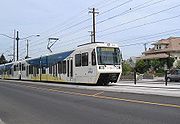
Articulated car
Encyclopedia



Railroad car
A railroad car or railway vehicle , also known as a bogie in Indian English, is a vehicle on a rail transport system that is used for the carrying of cargo or passengers. Cars can be coupled together into a train and hauled by one or more locomotives...
which are consist of a number of smaller, lighter cars which are semi-permanently attached to each other and which share common trucks
Jacobs bogie
Jacobs bogies are a type of rail vehicle bogie commonly found on articulated railcars and tramway vehicles....
. They are much longer than single passenger cars, and on the TGV Réseau
SNCF TGV Réseau
The SNCF TGV Réseau trains were built by Alstom between 1992 and 1996. These TGV trainsets are based on the earlier TGV Atlantique.The first Réseau sets entered service in 1993. Fifty dual-voltage trainsets were built in 1992-1994, numbered 501-550. A further 40 triple-voltage trainsets, numbered...
, for example, 8 cars are joined this way. Because of the difficulty and cost of separating each car from the next, they are nearly always operated as a single unit, often called a trainset.
Passenger cars
Articulated passenger cars are becoming increasingly common in Europe and the US. This means that the passenger cars share trucks and that the passageways between them are more or less permanently attached. The cars are kept in "trainsets" and not split up during normal operations. There is a safety benefit in that if the train derails, it is less likely to jackknifeJackknifing
Jackknifing means the folding of an articulated vehicle such that it resembles the acute angle of a folding pocket knife. If a vehicle towing a trailer skids, the trailer can push it from behind until it spins round and faces backwards. This may be caused by equipment failure, improper braking, or...
and modern construction techniques thankfully prevent telescoping
Telescoping (railway)
In a railway accident, telescoping occurs when the underframe of one vehicle overrides that of another, and smashes through the second vehicle's body...
.
Articulated Cars are not however a new idea. Many British Railways in the first half of the 20th century frequently rebuilt older, shorter cars into articulated sets, and the Great Northern Railway in Britain built suburban car sets new. In the 1930s, a number of streamlined trains built for the London and North Eastern Railway
London and North Eastern Railway
The London and North Eastern Railway was the second-largest of the "Big Four" railway companies created by the Railways Act 1921 in Britain...
also made use of articulated technology.
Freight cars
Manufacturers such as Gunderson make articulated, low-floor "well" cars, articulated trailer carriers and articulated autoracks.Advantages and disadvantages
Articulated cars have a number of advantages. They save on the total number of wheels and trucks, reducing initial cost, weight, noise, vibration and maintenance expenses. Further, movement between passenger cars is safer and easier than with traditional designs. Finally, it is easier to implement tilting schemes such as the TalgoTalgo
Talgo is a Spanish manufacturer of railway vehicles. It is best known for a design of articulated railway passenger cars in which the wheels are mounted in pairs, but not joined by an axle, and being between rather than underneath the individual coaches...
design which allow the train to lean into curves. The trucks
Bogie
A bogie is a wheeled wagon or trolley. In mechanics terms, a bogie is a chassis or framework carrying wheels, attached to a vehicle. It can be fixed in place, as on a cargo truck, mounted on a swivel, as on a railway carriage/car or locomotive, or sprung as in the suspension of a caterpillar...
of the Pendolino
Pendolino
Pendolino is an Italian family of tilting trains used in Italy, Spain, Portugal, Slovenia, Finland, Russian Federation, the Czech Republic, the United Kingdom, Slovakia, Switzerland, China and shortly in Romania and Poland...
are entirely under the coach. The trucks of the LRC passenger cars
LRC (train)
LRC is a bilingual acronym for Light, Rapid, Comfortable or Léger, Rapide, et Confortable, the name of a series of lightweight diesel-powered passenger trains that were used on short- to medium-distance inter-city service in the Canadian Provinces of Ontario and Quebec...
built by Bombardier Transportation
Bombardier Transportation
Bombardier Transportation is the rail equipment division of the Canadian firm, Bombardier Inc. Bombardier Transportation is one of the world's largest companies in the rail-equipment manufacturing and servicing industry. Its headquarters are in Berlin, Germany....
are entirely under the cars as well.
Disadvantages primarily relate to lesser operational flexibility. For example, additional cars cannot readily be added to an articulated trainset to accommodate peaks in traffic volume and a mechanical malfunction in one car or power unit can disable an entire trainset.
See also
- Air brakeAir brake (rail)An air brake is a conveyance braking system actuated by compressed air. Modern trains rely upon a fail-safe air brake system that is based upon a design patented by George Westinghouse on March 5, 1872. The Westinghouse Air Brake Company was subsequently organized to manufacture and sell...
- Articulated Light Rail Vehicle
- Articulated trams
- Articulated vehicleArticulated vehicleAn articulated vehicle is a vehicle which has a permanent or semi-permanent pivoting joint in its construction, allowing the vehicle to turn more sharply. There are many kinds of articulated vehicles, from heavy equipment to buses, trams and trains...
- BogieBogieA bogie is a wheeled wagon or trolley. In mechanics terms, a bogie is a chassis or framework carrying wheels, attached to a vehicle. It can be fixed in place, as on a cargo truck, mounted on a swivel, as on a railway carriage/car or locomotive, or sprung as in the suspension of a caterpillar...
- TalgoTalgoTalgo is a Spanish manufacturer of railway vehicles. It is best known for a design of articulated railway passenger cars in which the wheels are mounted in pairs, but not joined by an axle, and being between rather than underneath the individual coaches...
- Jacobs bogieJacobs bogieJacobs bogies are a type of rail vehicle bogie commonly found on articulated railcars and tramway vehicles....
- Railway brakesBrake (railway)Brakes are used on the cars of railway trains to enable deceleration, control acceleration or to keep them standing when parked. While the basic principle is familiar from road vehicle usage, operational features are more complex because of the need to control multiple linked carriages and to be...
- Slack actionSlack actionIn railroading, slack action is the amount of free movement of one car before it transmits its motion to an adjoining coupled car. This free movement results from the fact that in railroad practice cars are loosely coupled, and the coupling is often combined with a shock-absorbing device, a "draft...
- Stadler GTWStadler GTWThe Stadler GTW, sold by Stadler Rail of Switzerland, is an articulated railcar for local transport. GTW stands for Gelenktriebwagen .-Description:...
- TGVTGVThe TGV is France's high-speed rail service, currently operated by SNCF Voyages, the long-distance rail branch of SNCF, the French national rail operator....
- Vacuum brakeVacuum brakeThe vacuum brake is a braking system employed on trains and introduced in the mid-1860s. A variant, the automatic vacuum brake system, became almost universal in British train equipment and in those countries influenced by British practice. Vacuum brakes also enjoyed a brief period of adoption in...

